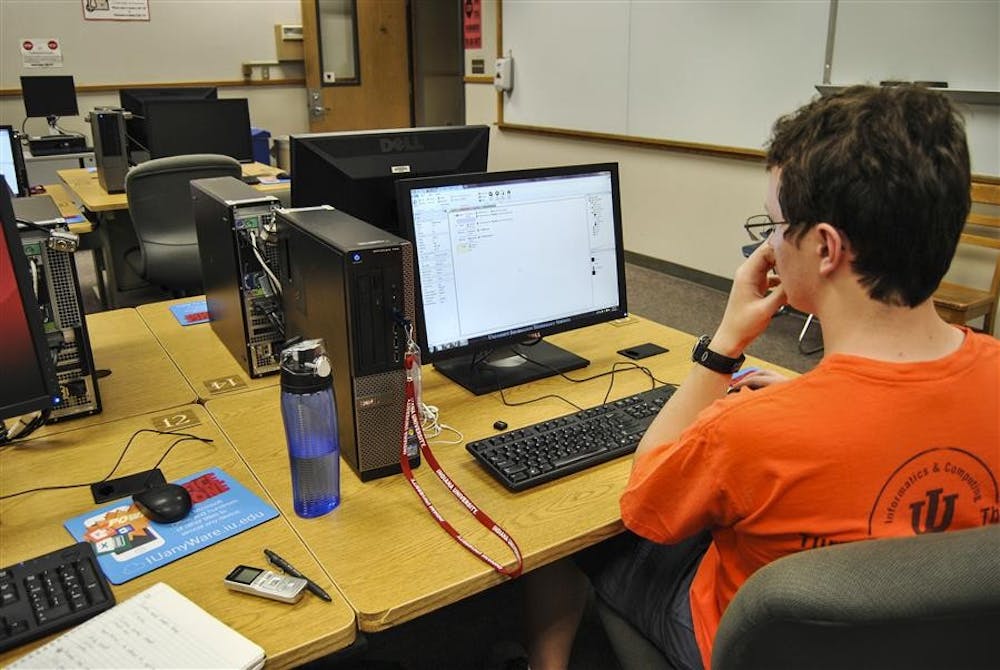Bringing a dream into reality was one of many goals Chabane Maidi hoped to accomplish at his camp last week.
In an effort to develop and open up the idea of working in the gaming world, Maidi helped start the Game Development Camp. The Camp just ended its first session this past Friday.
Maidi, who graduated from IU in 2009 with a degree in computer science and game design, said he doesn’t believe area high schools offer enough tutelage in the area of video game development and one of the goals of the camp was to offer the opportunity to learn and develop a video game to teens.
The camp was sponsored by the IU Department of Telecommunications and welcomed high school and college students ages 13 and up. It was aimed at teenagers and above interested in pursuing a career in game development.
The camp allowed students to make their own video games from scratch using the program Construct 2.
“The aim of the camp is to provide this game development resource to area teenagers,” Chris Roberts, PR/Marketing director for the camp, said. “Kids these days are surrounded by all this technology and along with that comes a love of video games.”
The idea for the camp originated from a conversation between Maidi and Professor Edward Castronova in the Department of Telecommunications.
“I had a flashback of how I never considered that game development was a realistic and respectable goal because we were never exposed to it in the high school setting, so we always went on to the fields that we considered to be realistic fields,” Maidi said. “So I decided if I’m gonna be able to foster the youth development scene in Bloomington, that I need to provide the opportunity I never had.”
After receiving the support of the Department of Telecommunications, Maidi and others involved with the idea moved forward in their efforts to pull a camp together in time for this summer.
Several speakers came to the camp, including Professors Edward Castronova of Telecommunications and Sean Duncan of School of Education, IU Game Development student group Hoosier Games and Academy award-winning visual effects producer Hoyt Yeatman.
“The student group talked about what it’s like to make an indie game as a student and the challenges that they face,” Maidi said.
Yeatman brought unreleased virtual reality simulation technology called Oculus Rift to the camp Wednesday and allowed students to demo the new game immersion device.
“He brought in this virtual reality device and the students were able to try it on for a few minutes each and I think that was kind of a blast,” Maidi said. “They were waiting in line, anxious to get this thing on their head.”
Nick Root, a senior at Bloomington High School South, said the theme of the game he was developing was music and rhythm.
“Music is the life-blood of the planet,” Root said. “Literally keeps the world going, keeps the rhythm alive and healthy. Something’s destroying it and causing it to play terrible music and such and it’s your job to try and stop whatever it is.”
Root said though he has really enjoyed the camp and has learned a lot, he doesn’t think implementing a similar program in high schools would be effective. The cost to attend this camp for one week averaged at $450.
“I think the idea is nice, but there’s problems with getting all the stuff for it, getting it set up and convincing people that it would actually be a good thing, because even if we got people to do it, they need to actually be working and it needs to be profitable for the school,” Root said.
Michael Tosti, a sophomore at Bloomington South, was working on making a game similar to the original version of Grand Theft Auto. Tosti was working on the animation for the game and said though it’s a “pretty fun job,” he learned the industry is not quite so open-armed.
“It’s kind of harder to get into the industry than it seems,” Tosti said.
Maidi was impressed with the way the students picked up on the concepts and logic of game development he presented them with. After two trial runs Maidi conducted of the project tutorials he had put together with college-aged students, Maidi assumed the high schoolers wouldn’t get through all the material. His perception changed after the first day the students were introduced to the material.
“Many of the students went out on their own exploring halfway through the first tutorial,” Maidi said. “They were able to pick up the material very quickly. I think this is testament to this idea that we have demand and that we’ve got students who are brilliant.”
Camp aims to make virtual reality a reality

Get stories like this in your inbox
Subscribe





